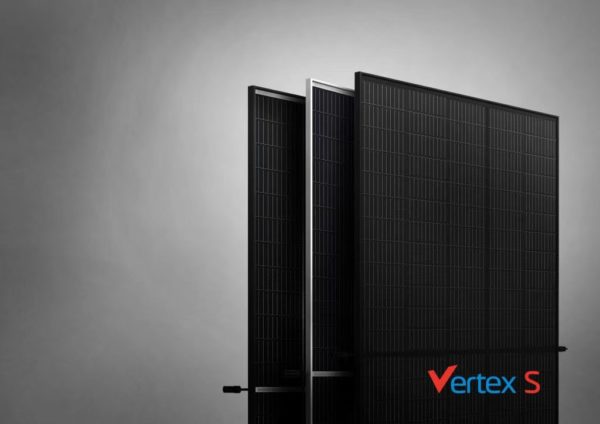PV Magazine: Mr. Zhang, thank you for acceptance of this interview. I know that Trina has already module product for residential market and that’s why I am a little bit curious why Trina launches this Vertex S module?
Zhang Yingbin: First I would like to talk about our design purpose of this Vertex S. Since the start of grid parity of PV, we saw a very promising solar PV market in future with estimated global annual installation up to 150 GW or even more in coming years. Meanwhile the distributed PV is taking bigger and bigger share of the total PV market. However, there was no any module which was particularly designed for small distributed PV including residential and C& I rooftop PV. The Vertex S of Trina Solar might be the first particularly customized PV module for this segment. Besides, as Trina is launching more and more module type based on 210mm wafer, we can also make a good small-size module product with 210mm wafer for our (distributed PV ) customers.

A particularly designed PV module for distributed PV market?
Yes, we have seen an obvious trend for modules with bigger and bigger power output like 535 W, 600 W and even more. But these bigger modules are fundamentally for utility scale power plant. They are not suitable for distributed PV which mainly on rooftop. Because for rooftop PV, no matter C&I and residential rooftop, the requirements of weight, dimensions, appearance and installation flexibility are quite different from those of utility scale PV. For example, the bifacial module type of 535 W weights about 32 kg for Dual-glass type and 28kg for backsheet type. However, in many places of Europe the installation restriction of weight is no more than 50 lb. for each manpower, which is about 22.7 kg. This means the present large power module product is not only hard to handle, but also illegal in installation operation by one person.
Another thing is the dimensions of the module. We were told by many of our European and Australia customers that they don’t want modules with length over 1.8 meter. Why? Because the limited size of roof slope, if the length is longer than 1.8m, it will be hard to install three rows and this will greatly reduce the utilization efficiency of the rooftop.
The third point is the appearance which usually is not an issue for those on utility scale PV but very important for distributed PV. We saw all kinds of cell and module technologies were used on module only for better performance, no any consideration of appearance. However, appearance is very important for distributed PV. For example, for some rooftop PV on terminal buildings of airport, reflection is forbidden, and black or at least dark color is required.
Installation flexibility is also critical for distributed PV and especially for residential rooftop PV. For those small rooftops of households, smaller module is with much higher installation flexibility than bigger ones. That’s our design purpose and the major concerns of Vertex S which I do believe is a best choice for distributed PV segment with changeable and complex scenarios for installation.
We know there are many module makers promoted module types for residential rooftop PV market, what is the difference between Vertex S and them?
As what I have said previously, the Vertex S might be the first PV module which has fully considered all related influential factors to distributed PV area, especially the residential PV. According to our calculation, Vertex’s major competitors including normal 60 pcs and/or 72 pcs module types in 158.75mm or 166 wafer sizes are with lower power output, which usually were 340 W or 370 W. While Vertex S is with 405 W. The new module product with 182mm wafer in 60 pcs and 72 pcs are with much bigger dimensions, either longer than 1.8m or heavier to over 50 lb, and will make the rooftop installation risky and expensive. Furthermore, Vertex S is with the highest conversion rate of more than 21% and our competitors are with typical 20.5% around.
— Rooftop installs using the Vertex S over other modules (158 @ 340W and 166@370W) on the market today will have around 10%~23% more capacity on the same area (case study in Shandong ,China ,Typical rooftop size :5.3m*16.7m in Shandong Province, China), equivalent to around 1.58~1.91KW based on a standard residential rooftop installation. The lifetime electricity generation will be up to 10%~23% higher than conventional modules.
Besides the Vertex S also attaches those characters of Vertex series, and with some upgrade. We provide 15 years’ product warranty for module quality, longer than previous 12 years. And for performance guarantee, we provide less than 2% for first year and averagely less than 0.55% in following years, which will have about 2% more power generation within lifespan.
So what are the values the Vertex deliver to your customers?
First for certain roof of either C&I or residential house, especially those with small size but complex shapes, Vertex S could provide more installation capacity than conventional products which make the PV plant more power generation and better financial performance. Second we provide better warranty conditions for Vertex S. And because of the smaller dimensions, transportation cost is significantly cut off since each container can load more pieces. Our calculation shows to cut off by 30-40% in Europe region. Meanwhile the easy installation would also reduce balance of system (BOS). Furthermore, our black modules would bring a more beautiful appearance.
So how will you promote the Vertex S module?
In domestic market of China, we will launch this new module together with our Trinahome and Trinablue solutions for our end users. While in overseas market, we now plan to promote the Vertex S module by our distribution network and start from high-end markets like Europe, Japan and Australian market first, A US launch is slated for next year, according to oversea capacity plan in the US market, and then spread to global markets like India, LAC gradually.
What capacity Trina Solar planned for Vertex S module?
We launch this product in late 2020, and in 2021 we will have 4-5 GW capacity prepared for Vertex S. And in 2022, the planned capacity will be about 8-10 GW. For future capacity I think it will depend on the market situation.
This content is protected by copyright and may not be reused. If you want to cooperate with us and would like to reuse some of our content, please contact: editors@pv-magazine.com.



1 comment
By submitting this form you agree to pv magazine using your data for the purposes of publishing your comment.
Your personal data will only be disclosed or otherwise transmitted to third parties for the purposes of spam filtering or if this is necessary for technical maintenance of the website. Any other transfer to third parties will not take place unless this is justified on the basis of applicable data protection regulations or if pv magazine is legally obliged to do so.
You may revoke this consent at any time with effect for the future, in which case your personal data will be deleted immediately. Otherwise, your data will be deleted if pv magazine has processed your request or the purpose of data storage is fulfilled.
Further information on data privacy can be found in our Data Protection Policy.